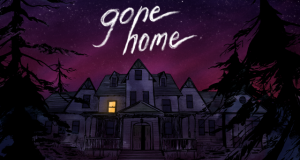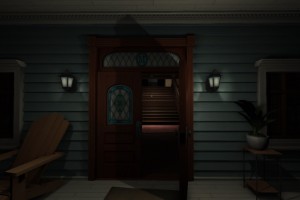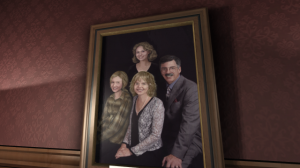Most of this blog is spent posting about my pretty popular Nintendo DS emulator, nds4droid. 3.5 million can’t be wrong (this is of course not true), but between working on it and playing obsessive amounts of Counter-Strike: Global Offensive, I don’t have time for too much else. So, if you’re just here for nds4droid, bear with me a bit why I explain why a new game, Gone Home had such a profound impact on me.

If I had to explain Gone Home to a gamer, I’d say it’s like a point-and-click adventure, only not. If I had to explain Gone Home to a non-gamer, I’d say that it almost perfectly realizes the potential the medium has a story telling device: it (almost perfectly) exploits the unique engagement with the viewer to deliver a story that’s in many ways more than the sum of it’s parts.
I won’t recap too much on what Gone Home is as a pure video game. I’m not a
 reviewer and don’t pretend to be (this is the first and probably one of the last posts of this type I’ll make), but the fact that places like The New York Times says that Gone Home is “is the greatest video game love story ever told,” should at least be motivation enough for further inspection.
reviewer and don’t pretend to be (this is the first and probably one of the last posts of this type I’ll make), but the fact that places like The New York Times says that Gone Home is “is the greatest video game love story ever told,” should at least be motivation enough for further inspection.
In Gone Home you play as Kaitlin Greenbriar, a 21-year old returning from a year studying abroad. In your year “gallivanting across Europe” as your younger sister Sam puts it, your family inherited a house from your something-might-be-wrong-upstairs uncle. You arrive on the door step late at night to find nobody home. A note on the door from the aforementioned Sam asks you not to go snooping around, and voice-mails on the answering machine suggest that something is seriously amiss.
From here, you objective is simply to discover; discover not only what, but more importantly how and why your family is absent to your homecoming. This is achieved through the familiar object inspection mechanism first perfected by games like L.A. Noire. But rather than a simple pixel hunting frenzy, the props in Gone Home are half of the perfection — even played at full 1080p the textures on nearly every object are rendered in perfect clarity, down to the nutrition labels on cans and the copyright text on books. One of my few moments of disconnect from the world around me was wondering exactly how the developers managed to get so many highly detailed textures into the video memory without a loading screen in sight.
To give away any more about what you’ll discover is to spoil an experience that’s best enjoyed one-on-one. Other sites will tell your more about what you’ll find — some have even completely revealed the mysteries — but I won’t. The most I’ll say about the plot of Gone Home is that it enables you to relive the nostalgia of youth. It’s supremely unfortunate that as we grow up we don’t — and cannot — appreciate the wonderful mystery of adolescence. The minutiae of our lives, the seemingly trivial in retrospect, from school principals who don’t understand to parents who view us as aliens from another planet, occupy the entire being of our existence. Gone Home lets us experience all of this from an empathetic view point and helps us — each in our own way — make the journey of Katie and Sam our own.
of adolescence. The minutiae of our lives, the seemingly trivial in retrospect, from school principals who don’t understand to parents who view us as aliens from another planet, occupy the entire being of our existence. Gone Home lets us experience all of this from an empathetic view point and helps us — each in our own way — make the journey of Katie and Sam our own.
We all view life through a lens of our experiences, and maybe Gone Home affected me as much as it did because I came into it as almost the perfect specimen: I grew up in the 90s in a middle-class house in America. I didn’t perfectly fit in, and I wasn’t perfectly understood. The art direction in Gone Home is executed so supremely that only someone who grew up in the era can fully appreciate. Super Nintendo cartridges, RCA cables and VHSes abound. But more than the decorations, the letters and hand-written notes (the largest section in the credits is that of handwriting) that serve as the main narrative device are truly human. When reading a letter from the mother’s old college roommate I couldn’t help but smile since I know this is exactly how my Mom communicates (trust me, I’m Facebook friends with her).
Gone Home isn’t a horror game, although it seems like it must be. The lone moment of “oh shit” comes when a light bulb goes out in a secret passageway. No one jumps out at you, there are no loud noises (except for the thunderstorm that rages outside). Instead, you’re left to rediscover what it means to be young, to be full of hope, fear, and what it was like to discover adulthood — both intellectually, and yes, sexually. By the time the two or three hours are up (yes, it’s that short), you can’t help but sit back in awe of a game that so completely understood what being young, dorky, and unsure was like.
In perhaps a great moment of meta-irony, near the end the player discovers a note from Katie’s grandfather to her father. The grandfather, an ivory tower academic, is backhandedly insulting his son’s greatest professional achievement. He notes, “The great authors speak of their life’s milieu in clear and honest tones, the lens crystal that refracts their thoughts without distortion.” I don’t know if the developers of Gone Home set out to do that, but as a twenty-five year old who grew up in middle-class suburbia, Gone Home helped me remember for a few hours what awkwardness, anger, and first love were like. That seems like a great work to me.
Gone Home can be purchased on Steam or DRM free at http://www.gonehomegame.com/.
This work is licensed under a Creative Commons Attribution-ShareAlike 4.0 International License.
Leave a Reply